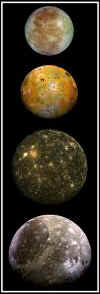Authors and Resources
The most significant contribution that Galileo Galilei made to astronomy was the discovery of the four satellites around Jupiter. Galileo first observed the moons of Jupiter on January 7, 1610 through a homemade telescope. In November of 1609, about five weeks prior to Galileo’s discovery another astronomer by the name of Simon Marius had claimed that he had discovered the moons first. However, since Marius did not publish his observations right away as Galileo had done, his claims were impossible to verify. Galileo had originally thought that he had seen three stars near Jupiter, strung out in a line through the planet. The next evening, these stars seemed to have moved the wrong way, which in turn caught his attention. Galileo continued to observe the stars and Jupiter for the following week. On January 11, a fourth star appeared. After a week, Galileo had observed that the four stars never left the vicinity of Jupiter and appeared to be carried along with the planet, and that they changed their position with respect to each other and Jupiter. Galileo reached a point where he had determined that what he was observing were not stars, but planetary bodies that were in orbit around Jupiter. Because of this discovery it provided evidence in support of the Copernican system and showed that everything did not revolve around the Earth.
Galileo originally called the moons of Jupiter the “Medicean planets”, after the Medici family and referred the individual moons numerically as I, II, III and IV. This system was used up until the mid 1800’s when the moons were renamed after the astronomer who had discovered them. They were given the name of the Galilean moons, Io, Europa, Ganymede, and Callisto. These names for Jupiter’s moons were provided by Simon Marius, and were based on suggestions given to him by Johannes Kepler. It became apparent that naming the moons by actual names would be less confusing than giving each moon a number as more moons were discovered.
Movie

The Galilean Moons
Ganymede, Callisto, Io and Europa
